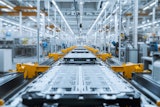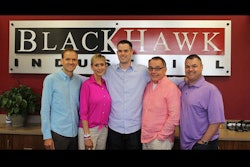This article originally appeared in the July/August print edition of Industrial Distribution. To view the full digital edition, click here.
As warehouses, distribution centers, manufacturing facilities, and repair shops become more advanced and efficient, the element of facility lighting can’t be overlooked. Industrial machine lighting is a niche but profitable segment, as different trades need proper lighting to get the job done right and safely. Inadequate light or poor installation makes a job site unsafe, and lamp failure results in downtime and production lost.
"The most common complaint about industrial machine lighting is it isn’t bright enough," says Les Kaminski, Technical Sales Manager for Wheeling, IL-based Waldmann Lighting. "Insufficient machine lighting can impact safety, impede proper setup, and ultimately affect quality control."
Kaminski recommends using a light meter as close to the area to be illuminated as possible. Light meter measurements will be in either lumens or foot-candles. This will establish a benchmark for the current light level that is considered insufficient for the work area. Then, you can establish a range requirement for replacement fixtures to meet the illumination needs for the application.
There are three types of measurements — lumens, lux and foot-candles — that will assist you recommending an appropriate lighting fixture. Lumens measure the total amount of light created by the light source. Lux and footcandles is a measure of the amount of light delivered to a specific area. Manufacturers’ spec sheets typically list lux in three ranges: minimum, maximum, and average. Use the average lux to estimate the light delivered to a specific work area. Another common metric for fixtures is lux per watt (lux/watt) of delivered light. Similar to miles per gallon, lux per watt is a common measure when choosing an industrial machine light to determine efficiency. Remember that the average lux on a spec sheet reflects the delivered light to the work space rather than overall light created by the light source.
| LED Fixture | |
| Power Consumption: | 21W |
| Lumen Package: | 1350 |
| Average Lux: | 273 |
| Lux/Watt: | 13 |
| Flourescent Fixture | |
| Power Consumption: | 36W |
| Lumen Package: | 2900 |
| Average Lux: | 160 |
| Lux/Watt: | 4.4 |
LED and fluorescent lighting are commonly used in industrial machines lights. When comparing the two technologies, the key measurement is delivered light to the work space; not the number of lumens. Waldmann Lighting provides the example to the right that shows, based solely on lumens, the fluorescent fixture would seem to be the brighter light. The fluorescent fixture, however, has a number of light loss factors including ballast factor, ambient fixture temperature, supply voltage variation, optical factor, and fixture surface. The fluorescent fixture’s actual delivered light ultimately falls well below the LED fixture.
Once the actual delivered light target has been established, next is to consider what fixture will meet the performance needs of the work space. Will the fixture be exposed to metalworking fluids and lubricants? If so, an Ingress Protection (IP) rating of 67 or greater is desired, according to Kaminski. The first number reflects the level of protection from solid objects or materials. The second number reflects the level of protection from liquids. An IP67 rating means the fixture is totally protected from dust and protected against the effect of immersion up to 1 meter. "If temperature extremes are a factor, contact the manufacturer to determine the maximum temperature ranges suitable for the ballast, driver, LEDs, and/or lamp," Kaminksi says.
Trending
Undoubtedly, LED technology continues to be the name of the game in all facets of consumer lighting across all industries. LED’s performance, long service life, and minimal maintenance requirements have led to it replacing most other light sources in the machine tool environment. Newer LEDs use less energy while maximizing light performance. Kaminksi says to look for new LED technology to provide excellent thermal management that will allow a minimum of 50,000 hours service life. In addition, some modern LED machine lights operate at ambient temperatures of up to 140 degrees Fahrenheit.
Value-Added
Kaminksi says there is an ongoing and potentially hazardous trend in machine lighting of trying to reduce maintenance and improve light quality by retrofitting older lamp technologies with modern LED fixtures. He warns, retrofitting an original fixture can create expectations for peak performance that the modified fixture was not engineered to meet. "Consider replacing technology instead of retrofitting," Kaminski says. "For example, there are high-performance LED fixtures available that are extremely effective and can easily upgrade tube lights to LED technology."
The good news is distributors don’t have to be experts in industrial machine lighting if they partner with a reputable, experienced lighting manufacturer who is. Lighting manufacturers share their expertise and support their distributors through training, direct on-site visits, or through technical support. "Distributors should partner with their manufacturers for fixture trials or demonstrations on the customer’s machines before purchasing to experience the quality of high-performance lighting," Kaminksi says. "Then, both the distributor and customer can confidently purchase the ideal fixture for the application."
Looking Ahead
LED industrial machine lighting technology will only continue to get better. Lighting will become more efficient – lumens per watt – smaller and thinner, and last longer. To keep up with the latest developments, Kaminski again recommends finding a reputable manufacturer to partner with. "Distributors must continue to invest in research and development, adapt quickly, and help them grow their product portfolio with the latest lighting technological advances."























